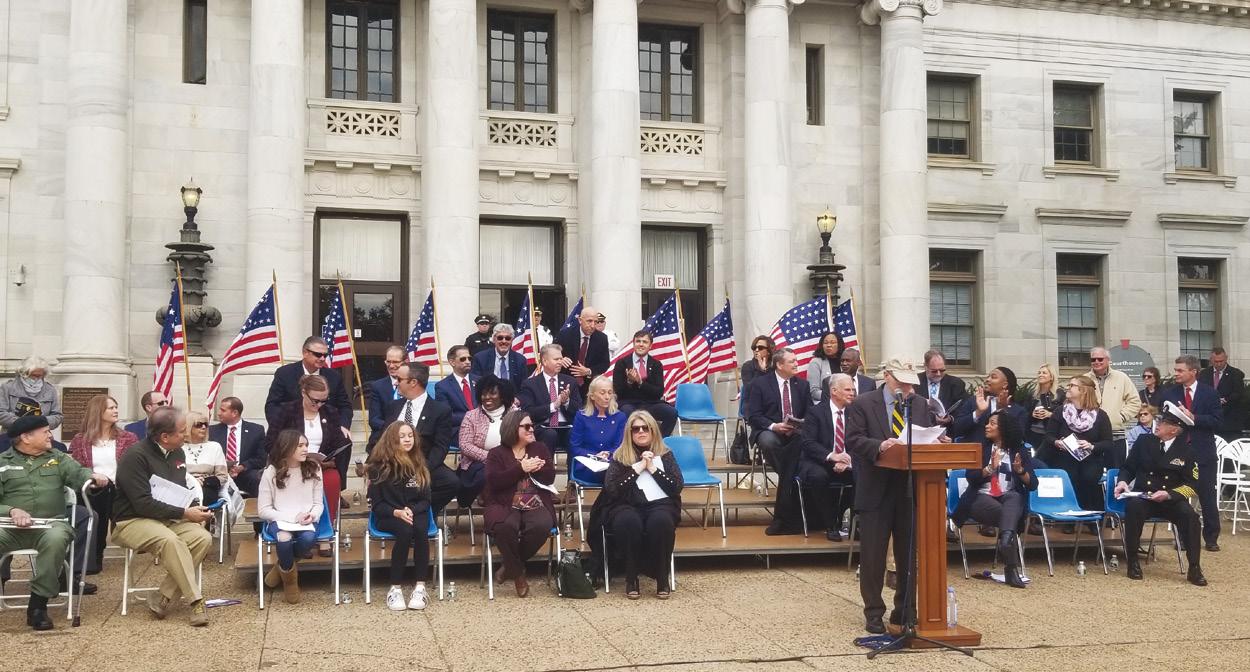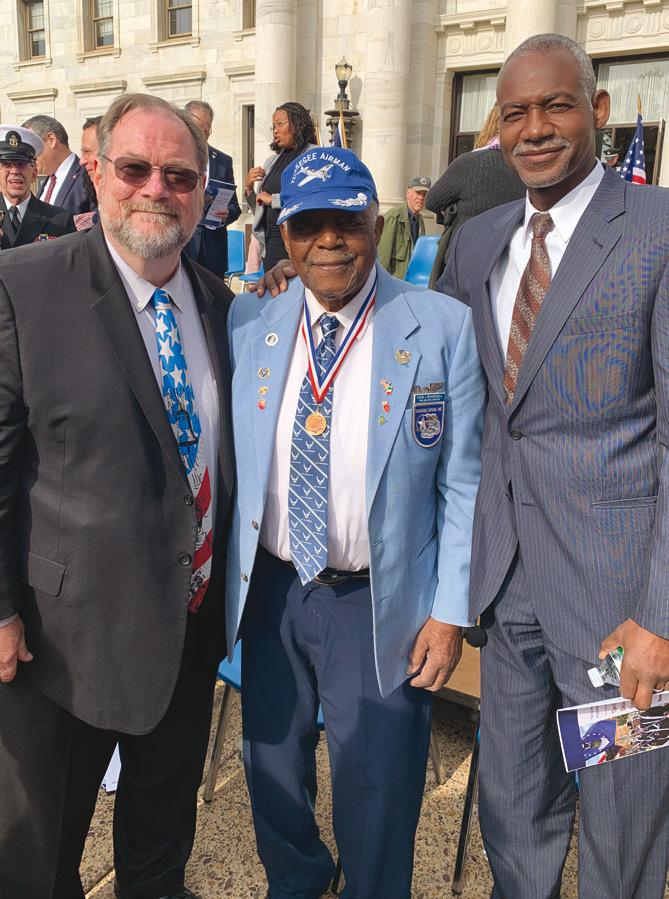
8 minute read
Service, Sacrifice & Appreciation
From simple acts of gratitude, to elaborate parades, America honors all those who served on Veterans Day and the yearly celebration was back in full swing in Media, Delaware County, at 11:11 a.m. on November 11, 2021, with the theme of Afghanistan Veterans.
The 61st annual parade included six divisions of veteran soldiers, sailors and Marines who received a warm welcome from the assembled thousands that filled the town to welcome them. In addition to veterans, five marching bands, historic reenactors, fire trucks First Responders, and veteran supporters took part in the hour-long parade, reportedly the largest in Pennsylvania.
For so many Veterans, this day is about more than just a parade, it is about service, sacrifice and appreciation. For 61 years, the parade has been just a small way to say thank you to all those who have served.
The celebration featured vocalist Ashli Rian Rice, who performed America the Beautiful, A Hero, and God Bless America. Her vocal ability is indeed world class, as it has been described by the Philadelphia Inquirer. You may have heard of Ashli; she has been the featured national anthem singer for the Major League Soccer team, The Philadelphia Union, rendering the National Anthem for the last 3 seasons; she has performed her rendition of the anthem for the National Soccer Coaches Convention at the Pennsylvania Convention Center; and most recently, Ashli performed the anthem at the Wells Fargo Center for the NCAA champions Villanova basketball team.
A fine set of speakers graced the steps of the Media Courthouse in celebration of our Veterans in 2021, including: Media’s own, Mayor Bob McMahon; Congresswoman Mary Gay Scanlon; Congressman Conor Lamb (Western PA); PA Attorney General Josh Shapiro; and two Delaware County school students who won a veterans essay contest. Also present were numerous veterans including Tuskegee Airman Dr. Eugene Richardson Jr., James Ziegelhoffer, Ruthie Severino, and representatives of the PA Veterans Museum.
The celebration welcomed Cedric Leighton, a retired United States Air Force Colonel and intelligence officer, as the Grand Marshal of the parade. During his 26-year Air Force career, Colonel Leighton served in a variety of intelligence assignments. These ranged from tactical tours with a mobile Signals Intelligence squadron to headquarters assignments at the Pentagon. He deployed five times to the Middle East, witnessed the fall of the Berlin Wall, and coordinated sensitive intelligence operations while assigned to US Special Operations Command. While serving in the Pacific Theater, Colonel Leighton provided extensive intelligence training to allied and partner nation military forces. He developed an innovative intelligence dissemination system that was implemented on 9/11 and is still in use today. Colonel Leighton provided extensive over-the-horizon intelligence support to US and Coalition forces in Afghanistan and was the key provider of specialized intelligence support for the “Shock and Awe” phase of Operation Iraqi Freedom. For these efforts, he was awarded the Bronze Star. After serving as a Squadron Commander, Colonel Leighton served as the Deputy Director for Warfighter Support and Integration in the Intelligence Directorate of the Joint Staff at the Pentagon and then became the Deputy Director of Training for the National Security Agency. In addition to the Bronze Star, Colonel Leighton’s other awards include the Defense Superior Service Medal, the Defense Meritorious Service Medal, 7 Meritorious Service Medals, and the Humanitarian Service Medal.
In his post-military career, Colonel Leighton is a strategic and cyber risk consultant and serves as a Military Analyst for CNN. He is heavily involved in the effort to bring our Afghan allies to safety.
“I submit that the challenge of our times is that the valor of our veterans has continually secured our freedoms for over 245 years and no matter the challenge, the American veteran is unique among warriors. We do not seek riches, we do not seek plunder, we do not pillage, and instead the American veteran brings freedom… not just to our citizens but to people all over the world.” … Colonel Leighton
NB: While we celebrate our Veterans each and every day, Governor Tom Wolf on October 6, 2021, signed Senate Bill 248, which establishes Persian Gulf War Veterans Day on March 6, Global War on Terrorism Veterans Day on October 7, and First

Responders Day on September 27.
Tuskegee Airman Dr. Eugene Richardson stole the show for me! Submitted by David Keller Trevaskis, Esquire, Pro Bono Coordinator, PBA … Pictured after the event is David Trevaskis, Esquire (left); Philadelphia Common Pleas Judge Giovanni Campbell (right), a student of Trevaskis’ at Temple Law School; and center, Tuskegee Airman Dr. Eugene Richardson.
Tuskegee Airman Dr. Eugene Richardson became interested in flight as a young boy in 1930 when his father and a friend took him along to see the Colored Air Circus, a group of Negro aviators performing an airshow in Mansfield, Ohio. Driven by pure interest to fly, he decided to join the Army Air Corps to become a pilot.
When he turned 17, he signed up to take a pilot qualification test. His father eventually gave his permission and signed the parental permission papers needed since Richardson was still underage. He passed the test and a few months later at the age of 18 he was sent to Keesler Field in Mississippi for 3 months of basic training. From Keesler he went on to Tuskegee Army Airfield for 40 weeks of training (10 weeks of pre-flight, 10 weeks of primary, 10 weeks of basic, 10 weeks of advanced). Tuskegee held the civilian contract for pilot training for the Army Air Corps at that time and had 42 Negro civilian instructors. White trainees went to different bases for their 10-week training segments. After Tuskegee, he went to Eglin Air Base for gunnery training and then to Walterboro, SC for combat training. At Walterboro, Richardson learned to fly P-40s and P-47 aircraft. Tuskegee, Alabama for pilot training and subsequently received his pilot’s wings and officer’s commission on March 11, 1945, with class 45A.
Richardson had a dream of flying ever since attending an Ohio air show starring black stunt fliers in the 1930s. When he turned 17, he left his Camden home for Tuskegee University in Alabama, where he completed combat training a month before the war ended in May 1945. Qualified to fly fighter planes, he was not deployed because the war in Europe ended two months after he was commissioned. Richardson takes great pride in the achievements of his fellow Tuskegee men in Europe, where they gunned down 112 enemy aircraft in their signature red-tailed P-47s and P-41s and provided aerial protection for the bombers flying through the clouds over Germany.
The Tuskegee Airmen, the nation’s first black fighter pilots to see combat, did more than risk their lives for freedom in World War II; the outstanding combat record of black pilots shattered pre-war stereotypes and set the stage for historic changes in civil rights during the 1950s and ’60s.
“The fantastic functioning of black pilots in World War II inspired desegregation,” Richardson said. “That’s what it says on my medal.”
The Congressional Medal of Honor was awarded to Dr. Richardson and his fellow Tuskegee Airmen by President George W. Bush in the White House in 2006 and he’s still proud to wear it.

Of the 38 pilots in his class, 23 including Richardson graduated as fighter pilots and 15 as B-25 bomber pilots in Class 45A on March 11, 1945. Dr. Richardson was discharged in July 1946. He returned to Philadelphia where he finished his high school degree at the then-Temple High School where my father was one of his teachers. He did his undergraduate work at Temple and got his Masters’ and D.Ed. at Penn State. He pursued a successful career in education in the Philadelphia School System in which I had the privilege of working at one of his schools as a lawyer presenting civics programs.
He did not pursue a career in Aviation after his discharge from the service because, “there was nowhere for a Black aviator to go in the United States – only Tuskegee.”
Eugene J. Richardson Jr. was born on September 18, 1925, in Cleveland, Ohio.
His early education took place primarily in Toledo, Ohio. Dr. Richardson served in the Army Air Corps during WWII. He was a member of the group that became known as the TUSKEGEE AIRMEN. Eugene was living in Camden, NJ, when he earned the status of Pre-Aviation Cadet in the Army Air Corps. He entered active duty in October 1943, at Keesler Field, Mississippi for basic military training. In February 1944 Eugene went to
The Tuskegee Airmen are frequently referred to as the men who changed our nation. Long before the marches of Martin Luther King Jr., civil rights advanced in the jet stream of such African-American aviators as Benjamin O. Davis Jr. and Eugene Bullard.
“The performance of black pilots in World War II,” Richard stated, “proved that high levels of performance wasn’t the province of guys with light skin.”
A former teacher and principal, Richardson recounted the history of blacks in flight. The first black fighter pilot, he noted, was not a Tuskegee Airman. Eugene Bullard, a young Georgia man, flew with the French Foreign Legion during World War I.
Citing a report by the Army War College at Carlisle, Richardson said blacks who wanted to fly ran up against systemic prejudice before World War II. The report concluded, he said, that blacks had no leadership qualities.
Although Tuskegee Airmen flying distinctive red-tailed P-47 fighters shot down 111 German planes, three German jets and sunk a destroyer, they faced continued discrimination upon returning home. When they got off the gangplank upon returning home, there were signs saying blacks this way and whites this way, the same as when they left. •










